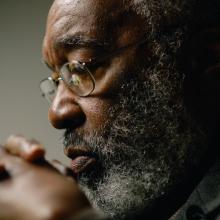cloud of witnesses
Here’s an irony: Standing at the memorial tree and experiencing a cloud of witnesses on this February day during Black History Month did indeed strengthen our resolve to keep fighting through the tears and the pain. We were mindful that on this particular day — Feb. 18, 2016 — the family of Sandra Bland would assemble later in the afternoon at the Houston Courthouse to hear response to their appeal for justice to be meted upon the Waller County sheriff and police. Our cacophony of voices called upon the Holiest of Holies to break the yoke of evil systems in which cronyism and political agendas thrived.
Vincent Harding died on Monday. One of my most important and dearest mentors is gone; there are countless other people across America — indeed, around the world — who are feeling the same as me.
But he really hasn’t gone; his memory and presence will continue on with us in a “cloud of witnesses,” which is the most important thing Vincent ever taught me.
At the Illiff School of Theology in Denver — the last place he worked and taught — Vincent’s title was “Professor of Religion and Social Transformation.” That was apt for someone who spent his life teaching and showing how faith was meant to transform the world, beginning with our own lives.
The first time I met Vincent Harding was at a talk he gave at Eastern Mennonite University titled something like “The People Around Martin Luther King Jr.” We expected to hear about all the famous civil right leaders from the movement. Instead, he spoke of those who had gone before, often many years before King, who had shaped, inspired, and sustained him like a family tree, a community of faith, or “a cloud of witnesses.”
THROUGH THE WRITER of the letter to the Hebrews we will be learning this month how the spiritual environment that upholds us as agents of God’s reign is richly, magnificently peopled. Entering into the spirit of this letter is like finding oneself worshiping in a great Byzantine church, in which the walls are blazing with frescoes and mosaics depicting the history of salvation and the saints in all their glorious variety. The writer extols the lineage of witnesses to God down the ages. We are asked to recognize them all as a crowd of supporters cheering us on. The writer insists that we live in vibrant awareness of the great and all-embracing community that God is forging. “But you have come to Mount Zion and to the city of the living God, the heavenly Jerusalem, and to innumerable angels in festal gathering, and to the assembly of the firstborn who are enrolled in heaven, and to God the judge of all, and to the spirits of the righteous made perfect, and to Jesus, the mediator of a new covenant” (Hebrews 12:22-24).
This is the antithesis of the bizarre theory that “religion is what the individual does with his own solitariness,” as the philosopher Alfred North Whitehead claimed. God is communion, as we try to express it in the doctrine of the Trinity. Life is interrelatedness. The baptismal creed of the church commits us to belief in the communion of saints because God recruits us for the struggle to build, sustain, and nurture community-where-God-reigns here on earth, as it is in heaven.


